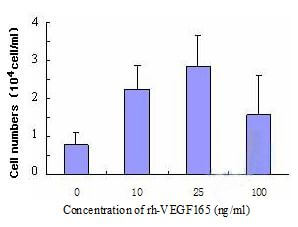| LT12011 |
|
10 µg |
| Freeze-dried powder |
|
20 kDa |
|
Escherichia coli |
|
≥ 95% |
|
< 1.0 EU/µg protein |
|
-20°C in the dark |
| 3 years |
|
Typically 2-5 ng/ml as determined in human umbilical vein endothelial cells (HUVECs). |
| Vascular endothelial growth factor (VEGF), also known as vascular permeability factor (VPF), is a potent mediator of both angiogenesis and vasculogenesis in human. Through alternative splicing, the single human VEGF gene produces six forms of human VEGF mRNA, which encode VEGF proteins of 121, 145, 165, 183, 189, and 206 amino acids, respectively. The 165-amino acid isoform (VEGF165) is the major gene product found in human tissue. It is the most effective angiogenic factor in the VEGF family. |
|

M: Protein Marker
Lane 1: rh-VEGF165
Figure 1: Analysis of rh-VEGF165 by SDS-PAGE

Figure 2: Proliferation of HUVECs as indicated by increased numbers of cells in the presence of rh-VEGF165 over the course of 96 h |
| It is recommended that the product be reconstituted with sterile water into a final concentration of 50 µg/ml at room temperature. Store the reconstituted product in aliquots at -20°C. Avoid multiple freeze-thaw cycles and exposure to frequent changes in temperature.
The use of strong acids and bases, strong oxidants, and high concentrations of organic solvents should be avoided to prevent denaturation.
|
| For research purposes only! Not for human or animal therapeutic or diagnostic use. |
 https://www.lifetein.com
100 Randolph Road, Suite 2D,
Somerset
USA
New Jersey
08873
https://www.lifetein.com
100 Randolph Road, Suite 2D,
Somerset
USA
New Jersey
08873
 https://www.lifetein.com
100 Randolph Road, Suite 2D,
Somerset
USA
New Jersey
08873
https://www.lifetein.com
100 Randolph Road, Suite 2D,
Somerset
USA
New Jersey
08873